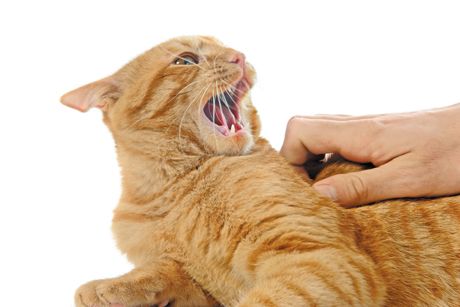Cat bites: The peril beyond the pain (script)
A study looks at the health risks associated with cat bite wounds in people.
Handling fearful, agitated, or painful cats can lead to bite injuries, as can improper restraint or handling techniques. Veterinarians, veterinary staff, and cat owners are clearly at risk for incurring this type of injury. So why be concerned, besides the obvious "ouch" factor?
Cat bites tend to cause puncture wounds and allow for bacterial inoculation of deep tissues. Our hands are often at risk when handling cats, and the superficiality of joint and tendon structures in the hand increases the risk of more serious infection. A retrospective review of patients with cat bite injuries to the hand has revealed some risk factors associated with the need for hospitalization and more aggressive treatment of these types of injuries.

GETTY IMAGES/CYNOCLUB
Records of nearly 200 patients presenting for cat bite injury to the hand over a three-year period were evaluated. Most were middle-aged women, and of the patients included in the study, 30% required hospitalization for intravenous antibiotic therapy and, in many cases, surgical irrigation and wound débridement. Complications were common in this group of patients who, on average, spent slightly longer than three days in the hospital. Abscess formation, tendon or nerve involvement, and loss of joint mobility even after successful treatment of the infection were consequences in some of these patients.
The most significant factors associated with the decision to hospitalize patients and pursue more aggressive therapy were not the length of time before patients sought medical attention nor any specific blood work abnormalities or bacterial culture results, but rather the presence of erythema, swelling, or pain and the location of the wound over a joint or tendon. Smokers and immunocompromised individuals were also at higher risk for hospitalization.
The bacterium associated with the infections was most commonly Pasteurella multocida, a normal oral flora of healthy cats. Amoxicillin-clavulanate was the antibiotic of choice for initial outpatient therapy in this study. Although other studies have demonstrated that early prophylactic administration of antibiotics can significantly decrease the risk for developing infection, identifying which patients will eventually require more aggressive treatment has not been easy; 14% of the people treated initially on an outpatient basis in this study subsequently required hospitalization.
The take-home: Seeking medical attention for cat bites to the hand is always prudent. In this study, complete resolution took 13 days for outpatients and 30 days for the hospitalized group, emphasizing the significance and severity of these wounds. The results of this and other studies strongly suggest that patients with cat bites to the hand be carefully examined and that aggressive treatment, including hospitalization, be encouraged if any of the risk factors are present.
Babovic N, Cayci C, Carlsen BT. Cat bite infections of the hand: assessment of morbidity and predictors of severe infection. J Hand Surg 2014;39(2):286-290.
Listen to this study summary and others at dvm360.com/HYH.
Inhaled albuterol offers more accessible treatment option for elevated potassium levels in cats
April 2nd 2025A recent study explored the effect of inhaled albuterol sulfate in reducing blood potassium levels in felines, which offers a potential treatment option for urinary obstruction-related hyperkalemia
Read More









